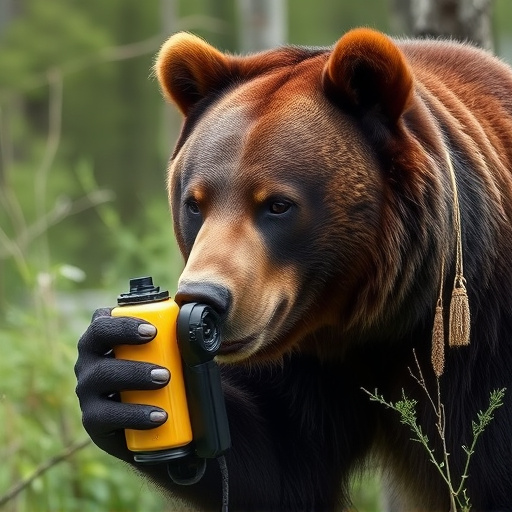Understanding bear behavior is key for wilderness survival and attack prevention. Recognize territoriality and follow protocols like making noise and using deterrents. Properly store and handle bear spray to avoid accidental discharges, which pose significant risks. Learn techniques for safe usage, first aid, and preventing encounters through secure handling practices.
In the vast wilderness, understanding bear behavior is paramount for your safety. This guide equips you with essential knowledge on preventing and managing potential bear attacks. Learn how to navigate encounters with these majestic creatures through proper storage and handling of bear spray, avoiding accidental discharge, and following safety tips. Should an encounter occur, we provide first aid and recovery strategies post-encounter, ensuring your well-being in the face of unexpected challenges like accidental bear spray discharge prevention.
- Understanding Bear Behavior: Key to Prevention
- Proper Storage and Handling of Bear Spray
- Accidental Discharge: Causes and Mitigation
- Safety Tips for Wilderness Encounters
- Post-Encounter: First Aid and Recovery Strategies
Understanding Bear Behavior: Key to Prevention
Understanding bear behavior is a critical component of wilderness survival, especially when dealing with potential attacks. Bears are wild animals with complex instincts, and their actions often depend on individual species, local conditions, and past experiences. Knowing what triggers a bear’s protective behavior can help hikers and campers prevent accidental encounters.
One key factor in bear attack prevention is understanding the concept of territoriality. Bears may defend their food sources or young, especially during specific seasons. Accidental Bear Spray Discharge Prevention is essential here; bears have been known to react aggressively when sensing perceived threats like spray. By respecting their space and following proper protocols for encountering bears, such as making noise to avoid surprising them, carrying bear deterrents, and knowing how to respond if a charge occurs, individuals can significantly reduce the risk of dangerous interactions.
Proper Storage and Handling of Bear Spray
Proper storage and handling of bear spray is crucial for accidental discharge prevention. Keep it in an easily accessible yet secure location, away from direct sunlight and extreme temperatures. Store it outside your living quarters or vehicle, ensuring it’s out of reach of children and pets. Always inspect the spray can before each use, checking for any signs of damage or pressure build-up.
When handling bear spray, make sure to follow safety guidelines strictly. Keep the nozzle away from your face and body, holding it at an angle while aiming towards potential threats. Practice proper technique during training sessions to ensure you can deploy the spray quickly and effectively when needed. Regularly review safety measures to minimize risks associated with accidental discharges.
Accidental Discharge: Causes and Mitigation
Bear spray, a powerful deterrent against aggressive bears, is a crucial tool for wilderness survival. However, one of the most significant risks associated with it is the accidental discharge, which can be dangerous not only to the user but also to wildlife and nearby individuals. These incidents often arise from improper handling, unexpected triggers, or failure to understand the spray’s mechanics.
To mitigate the risk of accidental bear spray discharge, users must prioritize safety measures. This includes storing and carrying the canister securely, ensuring proper training in its use, and understanding the wind conditions. Regular maintenance of the equipment and awareness of one’s surroundings are vital. Users should also be educated on the spray’s range, effectiveness, and optimal deployment techniques to minimize the chances of unintentional discharge while maximizing protection during a bear encounter.
Safety Tips for Wilderness Encounters
In any wilderness survival scenario, encountering bears is a potential risk. To minimize this threat, it’s crucial to understand bear behavior and follow safety protocols. One key practice is learning proper handling techniques for bear deterrents like accidental bear spray discharge prevention. Always ensure your spray is secured and familiarise yourself with its usage before venturing into bear country.
When navigating through wild areas, make noise to signal your presence; this can help bears spot you from a distance and potentially avoid confrontation. Keep food stored securely in bear-resistant containers, and never leave camp without ensuring all remnants of food are properly disposed of. By adhering to these guidelines, adventurers can significantly reduce the likelihood of bear encounters turning dangerous.
Post-Encounter: First Aid and Recovery Strategies
After a bear attack, immediate first aid becomes crucial for recovery. If a person has been sprayed accidentally by bear spray, it’s essential to act swiftly. First, move the individual to a safe location away from the bear and ensure their breathing is not compromised. Remove any contaminated clothing, as bears may be attracted to scent trails left by these items.
Washing the affected areas with soap and water is recommended to minimize irritation. In cases of severe injuries, seek medical attention immediately. For accidental bear spray discharge prevention, it’s vital to understand proper handling techniques and store the spray in a secure manner. Always ensure the nozzle is facing away from you and others when in use, and never point or throw it towards any animal or person.
Understanding bear behavior and implementing proper safety measures, such as responsible bear spray handling, are key components of wilderness survival. By adhering to these guidelines, including strategies for accidental bear spray discharge prevention, you can minimize risks during encounters with these majestic animals. Remember, knowledge and preparation are your best defenses in the wild.
